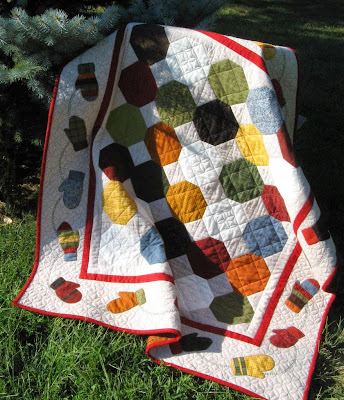Thank you, thank you, Sue!
It started with a quick pencil sketch.
As always, I took it to my husband for his opinion. When his face broke into a smile I knew it was okay.
I made the templates in the morning and spent most of the afternoon choosing fabrics. Lots of Christmas prints and a small scrap of a "flesh" colored solid. That "flesh" color could be anything on the spectrum from pale cream to deep ebony, but I chose the color that matches my own family for this one.
Trick # 1
"Where did you find the flesh color fabric?" my friend Midge, asked.
Quilting cotton in most flesh tones is pretty hard to come by, so I modified the color of my fabric with an easy trick. I started with Kona cotton in peach, then I used the old trick of altering the color of the fabric with tea.
 |
| The original Kona cotton and four little sample sections for testing color. |
Here are the instructions:
1. Get out bowl that is sufficiently large to hold your fabric with room to spare and place 2 teabags into the bowl for every cup of water that you will need to completely immerse your piece of fabric.
2. Pour boiling water over the tea bags and let it steep for about 10 minutes.
3. Drop the fabric into the tea. Swirl it a bit to ensure an even stain. If you need to leave the fabric unattended, make sure that no pockets or air are lifting sections of it to the surface.
4. When you think the fabric might be about the right color, rinse it in cold water and dry it. It will lighten as it dries. If the color isn't dark enough, put the fabric back in the tea bath for a bit longer. The fabric can be made several shades darker with extended time in the tea.
To achieve very dark stains you may need to reheat the tea with the fabric in it. That's what I did with the darkest sample in the photo below. It took about half an hour to reach that lovely, nut brown, flesh color.
 |
| Four shades of flesh tones achieved through being left in the tea for longer periods of time. They are placed on top of the original peach cotton. |
Trick # 2
Faces made of real flesh are not a solid color! Color adds health and beauty to a face. Why else would we need makeup?
My flesh colored fabric needed to look healthy and alive, too! Instead of makeup, I added color with colored pencils and embroidery floss. I started with a red pencil and a brown one.
Using a blunted red pencil I added a soft blush to the cheeks, the inner parts of the ears, and the nose. After that I added definition to the ears and nose with a very sharp brown pencil. I felt like I was a little girl again, coloring in my coloring book! Definitely playtime for me.
The eyes and mouth were embroidered, but they really don't have to be. Drawing them with a fine tipped magic marker is just fine. Just make sure to test the markers on a small scrap of your fabric first! Sometimes the markers will bleed into the fabric and ruin it.
Trick # 3
Some of the pieces in this pattern are pretty small, so they were a bit tricky to place. First I planned my layout, then I used a straight pin to get the pieces where I wanted them. I found that it was best to fuse one layer at a time to keep the pieces from slipping out of position under the iron. It helps enormously to avoid ironing back and forth on them. Simply press the iron straight down on top of the appliques and apply pressure.
Ta-da!
"Wrapped and Ready", the finished mug rug!
I'd be grinning too if I had my Christmas packages all wrapped and ready to go!
And now it's time to move on to the next project. If I'm not mistaken, somebody wanted a table runner. Back to the sewing room!





















































